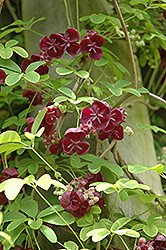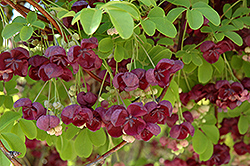Height: 30 feet
Spread: 24 inches
Sunlight:
![]()
![]()
Hardiness Zone: 4
Other Names: Chocolate Vine
Description:
A most vigorous vine, good for a quick screen on many landscape structures; no uniquely overwhelming features, but distinctively-shaped flowers and curious fruit add up to create interest in the landscape
Ornamental Features
Fiveleaf Akebia has clusters of fragrant deep purple flowers along the branches from early to mid spring, which are interesting on close inspection. It has bluish-green deciduous foliage which emerges burgundy in spring. The palmate leaves do not develop any appreciable fall color. The fruits are showy deep purple pods displayed from early to mid fall.
Landscape Attributes
Fiveleaf Akebia is a multi-stemmed deciduous woody vine with a twining and trailing habit of growth. Its relatively fine texture sets it apart from other landscape plants with less refined foliage.
This woody vine will require occasional maintenance and upkeep, and should only be pruned after flowering to avoid removing any of the current season's flowers. Deer don't particularly care for this plant and will usually leave it alone in favor of tastier treats. Gardeners should be aware of the following characteristic(s) that may warrant special consideration;
- Invasive
Fiveleaf Akebia is recommended for the following landscape applications;
- General Garden Use
Planting & Growing
Fiveleaf Akebia will grow to be about 30 feet tall at maturity, with a spread of 24 inches. As a climbing vine, it tends to be leggy near the base and should be underplanted with low-growing facer plants. It should be planted near a fence, trellis or other landscape structure where it can be trained to grow upwards on it, or allowed to trail off a retaining wall or slope. It grows at a fast rate, and under ideal conditions can be expected to live for approximately 20 years.
This woody vine does best in full sun to partial shade. It is very adaptable to both dry and moist locations, and should do just fine under average home landscape conditions. It is considered to be drought-tolerant, and thus makes an ideal choice for xeriscaping or the moisture-conserving landscape. It is not particular as to soil type or pH. It is highly tolerant of urban pollution and will even thrive in inner city environments. This species is not originally from North America.

